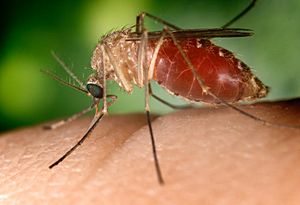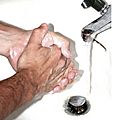Infection facts for kids

Infection happens when tiny living things, like bacteria or viruses, get inside your body. These tiny invaders then multiply and can make you sick. They might produce harmful stuff called toxins or damage your body's tissues. An infectious disease is an illness you get because of an infection. People also call them 'transmissible' or 'communicable' diseases because they can spread from one person to another.
Contents
What are common infectious diseases?
There are many types of infectious diseases. They are caused by different kinds of tiny living things.
Diseases caused by bacteria
Bacteria are tiny, single-celled organisms. Some bacteria can cause diseases, but many are harmless or even helpful!
- Tuberculosis (often called TB)
- Bubonic plague
- Pertussis (also known as whooping cough)
- Leprosy
Diseases caused by viruses
Viruses are even smaller than bacteria. They need to get inside your body's cells to multiply.
Diseases caused by fungi
Fungi are a type of living organism that includes molds and yeasts. Some can cause infections.
Diseases caused by parasites
Parasites are organisms that live on or in another organism (the host) and get their food from or at the expense of their host.
- Malaria (spread by mosquitos)
- Schistosomiasis (caused by flat worms)
- Chagas disease
Diseases caused by proteins
- Prions are unusual proteins that can act like infectious agents. They can cause rare brain diseases.
Diseases caused by many agents
Some illnesses can be caused by different types of infectious agents. For example, diarrhea can be caused by bacteria or viruses.
This is just a small list. There are many more diseases, both infectious and non-infectious. You can find a longer list here: common diseases.
How do people get infectious diseases?
Some diseases spread very easily from person to person. Others are harder to catch.
If someone with the flu, a cold, measles, or a sore throat coughs or sneezes, tiny droplets with germs can spread. If you breathe these in or touch surfaces they landed on, you might get sick.
Other conditions, like AIDS, herpes, and Hepatitis B, need closer contact to spread. They can be passed through blood transfusions or by touching infected blood or other body fluids.
How can we stop infectious diseases?
There are simple ways to help stop the spread of germs and stay healthy:
- Cover your mouth and nose every time you cough or sneeze.
- Only drink clean, safe water.
- Make sure your meat is cooked all the way through.
- Wash your hands often with soap and water, especially after using the bathroom and before eating.
How are infectious diseases treated?
The way an infectious disease is treated depends on what caused it.
- Bacterial infections are usually treated with special medicines called antibiotics, like Tetracycline and Penicillin.
- Viral infections are not killed by antibiotics. They need different medicines called antivirals. For example, zidovudine is an antiviral medicine used to treat HIV/AIDS.
- Fungal infections are treated with antifungals, such as miconazole.
- Parasitic infections are treated with anti-parasitic medicines, like Praziquantel.
Some infectious diseases don't have good treatments. For example, there's no medicine that works well to cure West Nile Virus or Rabies. That's why it's so important to try and avoid getting these diseases in the first place.
Sometimes, mild infectious diseases, like the common cold, go away on their own without any special medicine.
Preventing diseases with immunizations
Many diseases can be prevented with immunizations, also known as vaccines. An immunization helps your immune system learn how to fight off a specific germ before you even get sick. This way, if you come into contact with the germ later, your body is ready to protect you.
Examples of diseases prevented by immunizations include polio, tetanus, and pertussis.
In some amazing cases, if enough people get immunized, a disease can be completely removed from society. Smallpox is a great example. This virus used to kill many people, cause blindness, and leave terrible scars. But thanks to a worldwide immunization effort, no one has had smallpox in over thirty years!
Images for kids
-
Four nutrient agar plates growing colonies of common Gram negative bacteria.
-
Washing one's hands, a form of hygiene, is an effective way to prevent the spread of infectious disease.
-
Mary Mallon (a.k.a. Typhoid Mary) was an asymptomatic carrier of typhoid fever. Over the course of her career as a cook, she infected 53 people, three of whom died.
-
East German postage stamps depicting four antique microscopes. Advancements in microscopy were essential to the early study of infectious diseases.
-
Herrerasaurus skull.
See also
 In Spanish: Infección para niños
In Spanish: Infección para niños










